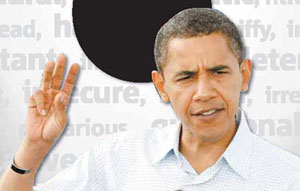$3 trillion! Senate, Fed, Treasury attack crisis

WASHINGTON (AP) — On a single day filled with staggering sums, the Obama administration, Federal Reserve and Senate attacked the deepening economic crisis Tuesday with actions that could throw as much as $3 trillion more in government and private funds into the fight against frozen credit markets and rising joblessness.
“It’s gone deep. It’s gotten worse,” President Barack Obama said of the recession at a campaign-style appearance in Fort Myers, Fla., where unemployment has reached double digits. “The situation we face could not be more serious.”
If any more emphasis were needed, Wall Street investors sent stocks plunging, objecting that new rescue details from the government were too sparse. The Dow Jones industrials dropped 382 points.
The president spoke shortly after Senate passage of an $838 billion emergency economic stimulus bill cleared the way for talks with the House on a final compromise. In a display of urgency, White House chief of staff Rahm Emanuel traveled to the Capitol for meetings that stretched into the night with Democratic leaders as well as moderate senators whose views — and votes — will be key to any deal.
Separately, Treasury Secretary Timothy Geithner outlined plans for spending much of the $350 billion in financial bailout money recently cleared by Congress, and the Federal Reserve announced it would commit up to $1 trillion to make loans more widely available to consumers.
Taken together, the events marked at least a political watershed if not an economic turning point — the day the three-week old administration and its congressional allies assumed full control of the struggle against the worst economic crisis since the Great Depression.
The vote was 61-37 in the Senate to pass the stimulus, with moderate Republican Sens. Susan Collins and Olympia Snowe of Maine and Arlen Specter of Pennsylvania joining Democrats in support.
Even before the vote, Majority Leader Harry Reid and House Speaker Nancy Pelosi met with Obama at the White House to go over the task ahead.
The Democratic leaders have long pledged to have legislation on Obama’s desk by mid-month, and some Democrats said there was an informal target of Wednesday for agreement on a bill that would likely wind up in the range of $800 billion.
The political urgency bumped up against other obstacles, though.
The House measure includes roughly $70 billion more spending than the Senate’s, but it lacks Senate-approved tax breaks totaling more than $100 billion for new car buyers, home purchasers and upper middle income families.
In a further obstacle, Collins and other Senate moderates — in both parties — signaled they will work to hold the cost of the final bill below $800 billion. That’s less than the $820 billion in spending and tax cuts combined in the bill that cleared the House as well as the $838 billion legislation the Senate wrote.
Additionally, Obama has campaigned particularly energetically to include funds for school construction in the bill. At the insistence of Collins, the Senate measure omitted money for that purpose, and it wasn’t clear whether she had eased her position on the presidential priority.
Whatever the cost of the final bill, it will add to the deficit, and that created another little-mentioned dilemma for the administration and Democrats.
Future spending bills on domestic programs or tax cuts will probably have a far more difficult time gaining the support necessary to pass without offsetting spending cuts or tax increases that would hold the deficit level.
Obama has campaigned energetically in recent days for passage of the stimulus bill, at the White House, on visits to other federal agencies, in his trip to Florida and a similar appearance Monday in a high-unemployment area of Indiana.
Reid depicted a president deeply involved in the compromise effort as well. He said Obama had “certain set ideas as to what he thinks should be done” but declined to elaborate.
The president set the context for the unfolding events Monday night at his first presidential news conference when he said, “With the private sector so weakened by this recession, the federal government is the only entity left with the resources to jolt our economy back into life.”
Geithner outlined some of the details, although he and aides left numerous questions unanswered.
“We have to both jump-start job creation and private investment, and we must get credit flowing again to businesses and families,” Geithner said at a news conference. He pledged to “fundamentally reshape” the financial industry bailout that began last fall under the Bush administration, and he announced that at least $50 billion would be spent helping homeowners facing foreclosure. He also said new steps would hold banks accountable for their use of bailout funds.
One element of the administration’s approach calls for using as much as $100 billion in federal bailout funds to give banks, hedge funds or other investors the incentive to purchase so-called toxic assets carried on the books of other financial institutions. The goal is to return struggling banks to health so they can resume making loans, and an administration fact sheet said the amount of government and private funds combined will be “on an initial scale of up to $500 billion, with the potential to expand up to $1 trillion.”
The Federal Reserve announced it would commit up to $1 trillion to purchase bonds or other assets backed by consumer loans. The Treasury will guarantee a portion of the Fed investment by putting up $100 billion, an increase from a $20 billion commitment that Bush administration had announced.
The goal of this program is to make it easier for consumers to buy cars or obtain student loans, small business loans or other types of credit that have dried up in recent months.
Geithner said $50 billion in bailout funds would be dedicated to an effort to prevent mortgage foreclosure of “owner-occupied middle class homes.” Few details were provided.
Associated Press writers Martin Crutsinger, Tom Raum, Jennifer Loven, Ann Sanner and Andrew Taylor contributed to this report.






























